Ghost in the Shell - Where to Start and What's Worth Watching (and Reading)
by Kevin Cormack,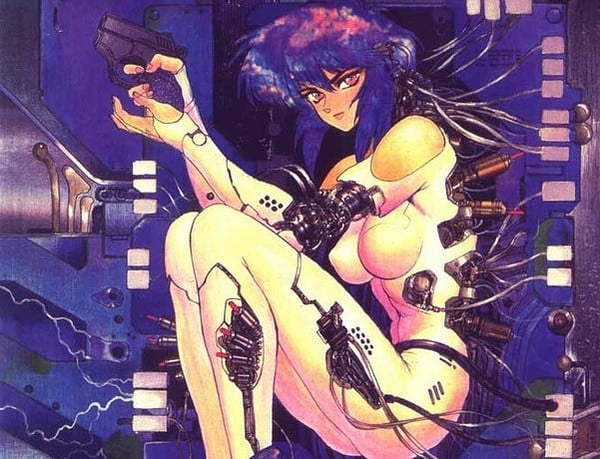
Back in 1995, Shirow Masamune was already renowned in the West for his manga (and their respective anime adaptations) Appleseed and Dominion Tank Police. Fan excitement was high for his next big manga, Ghost in the Shell (GitS), first published in English by Dark Horse Comics in monthly installments four years after its 1991 Japanese tankobon publication—and swiftly followed by Mamoru Oshii's movie version. Few fans at the time would have predicted that Shirow's goofy techno-geek manga would tower over his previous work, spawning a world-conquering media behemoth, deeply influencing popular culture — even Hollywood movies.
Almost thirty years after its Western debut, the sheer number of GitS manga, anime, novels, art books, and video games seem overwhelming to the uninitiated, especially with the recent announcement of yet another new anime adaptation from Science Saru due in 2026.
Where on Earth do you start? How much is even worth experiencing? Taking my cue from fellow ANN writer Lauren Orsini's excellent Mobile Suit Gundam franchise overview, here's an exhaustive list of everything GitS that's ever been available in English (and a few things that aren't…)
The Main Manga Continuity
What it is: Where better to start than with the manga that kicked everything off? Originally published in Japanese by Kodansha between 1988 and 1997, GitS' three volumes, along with Shirow's previous manga, were localized into English by legendary translator/editor Toren Smith and his Studio Proteus. Dark Horse distributed their excellent work after the original publisher Eclipse Comics went bust in the early 1990s. The continuity between volumes isn't always obvious and the various later anime adaptations emphasize very different aspects of the source material.
What it's about: In late 2020s Japan, biochip technology has advanced, so many people now have cyberbrains: physical implants allowing direct mind-to-internet connection. Such interfaces are unfortunately vulnerable to remote “cyberbrain hacking” by criminals. Even victims' “ghosts” (a catch-all term for mind/personality/soul) are at risk of corruption, damage, or being overwritten.
Public Security Section 9 is a clandestine special ops team, answerable only to the Japanese Prime Minister, whose role is to solve domestic (and sometimes international) cybercrime and cyber-terrorism. With unparalleled hacking skills and sharp military acumen, Cyborg Major Motoko Kusanagi is the cool, capable leader of Section 9's small task force. Her only remaining organic component is her brain. Thus, she often ponders just how human she remains.
What should I read first?: Start with the first volume, simply titled Ghost in the Shell.
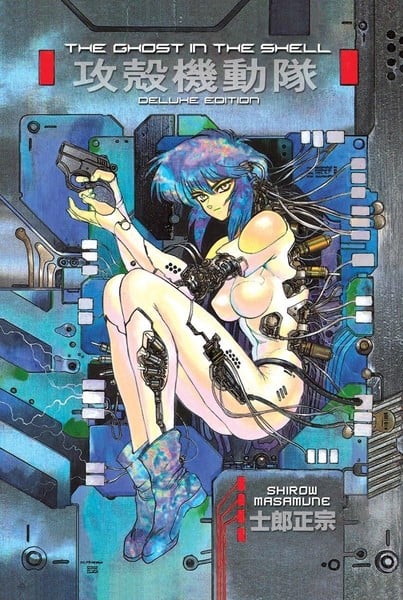
Ghost in the Shell
What it is: The original 11-chapter manga was first published in English as eight monthly flipped “floppy” comics with two extremely explicit pages depicting a lesbian cybersex ménage à trois removed by Shirow himself. These were later reinserted by Dark Horse in a single uncensored trade paperback edition that's now very out of print. English-language editions are now published by Kodansha USA (in trade paperback and on K Manga), and they remain censored. Honestly, we're not missing anything of value.
Worth reading?: Yes.
Why: It's easy to see why GitS inspired so many spin-offs and adaptations. For a manga that began serialization in 1988, it's incredibly prescient—especially as the world gradually catches up to Shirow's inspired vision. Main characters Kusanagi, Batou, Aramaki, and Togusa are iconic—as is the concept of “The Puppeteer”. GitS is frequently very funny, in addition to being thought-provoking and exciting. It needs to be read two or three times — slowly — to fully comprehend Shirow's complex concepts, rewarding the reader's patience. This isn't a manga to idly flick through.
Readers unfamiliar with Shirow's idiosyncratic art style may find the abrupt switching from full-color pages to B&W art at the beginning of most chapters to be a little jarring—and the frequent comedy-deformation of character designs during otherwise intense, serious scenes to induce some tonal whiplash. There's also Shirow's constant, extremely horny objectification of female characters juxtaposed with lengthy exposition dumps of semi-incoherent technobabble which some readers may not enjoy.
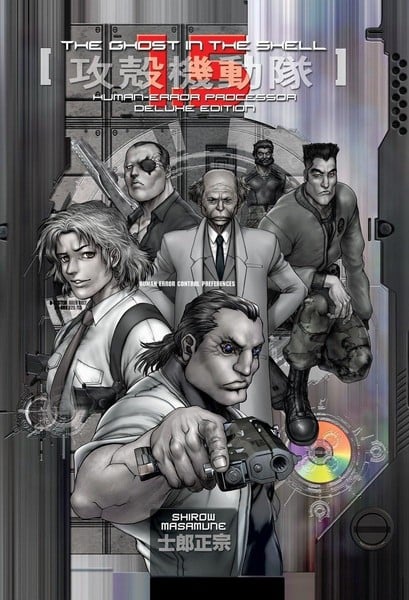
Ghost in the Shell 1.5: Human Error Processor
What it is: Shirow's aborted first attempt at a GitS sequel. It's more of a standard police procedural drama. First published in English over eight floppy issues by Dark Horse in 2006, it's now available in trade paperback from Kodansha USA and digitally on K Manga.
Worth reading?: Maybe.
Why: At only four chapters, and around half the length, Human Error Processor is a less satisfying read than its predecessor. It's very episodic, focusing mainly on Batou and Togusa. Kusanagi only appears in a single chapter, and it's easily the best of a mediocre bunch. Shirow's art has matured, looking more serious and less playful. There's less humor in general, less color, and Kusanagi's absence rips the soul from the story. There's little wonder Shirow abandoned it to rethink the entire thing. It's a shame that some lingering plot threads are never resolved, though.
Human Error Processor is at least partly valuable for introducing new Section 9 recruits Proto and Azuma who show up later in the SAC 2nd GIG TV show and some themes and story elements are used in the Solid State Society movie. The scene of Kusanagi ripping her own arms apart as she tries to pry open the canopy of an armored tank is directly referenced in the 1995 movie and Stand Alone Complex.
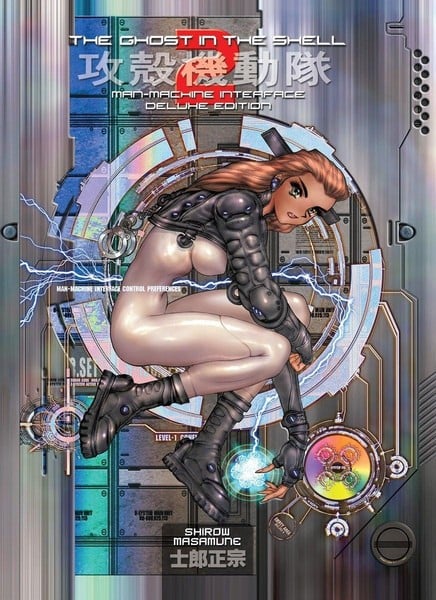
Ghost in the Shell 2: Man/Machine Interface
What it is: Shirow's second go at a sequel, released in multiple revised versions George Lucas-style, before belatedly coming West in 2003. First published over eleven monthly short floppy comics by Dark Horse, it's now available in trade paperback format from Kodansha USA and digitally on K Manga. The original Japanese printing contains an even more horrifying cybersex scene than the first volume and Shirow himself removed it from all subsequent Japanese printings plus the English editions. Best to pretend it doesn't exist.
Worth reading?: No.
Why: Unfortunately, Man/Machine Interface (MMI) is where Shirow disappears up his own I/O port. Overblown, impenetrable, and difficult to follow, it's amazing how such a detailed manga can suffer from an almost total absence of a coherent plot. There's a reason that every animated adaptation since has almost completely ignored the existence of MMI. It's awful. There are a staggering number of full-color pages but the CG backgrounds and clumsy compositing look awkward and dated now—they contrast with the more traditional B&W pages even more jarringly.
I've read MMI multiple times, and I still have no idea what Shirow is trying to say about it. Any interesting ideas are drowned beneath dense technobabble. There are no sympathetic characters with identifiable goals. MMI focuses heavily on the digital avatar “Motoko Aramaki”, completely neglecting Section 9's other characters. The “dialogue” reads like someone fed a tech textbook into a malfunctioning generative AI and published the garbled results, accompanied by hundreds of pictures of generously endowed, scantily clad women contorted into heavily sexualized, horribly uncomfortable positions. Sometimes I'm sad Shirow left the manga business. Then I remember MMI.
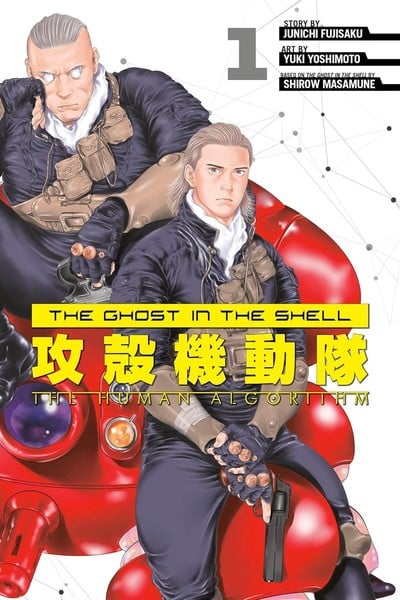
Ghost in the Shell: The Human Algorithm
What it is: Essentially Ghost in the Shell 1.75, written by Junichi Fujisaku and illustrated by Yuki Yoshimoto. It's a multiple-volume non-Shirow manga series designed to fill in the gaps between 1.5 and MMI. It began in 2019 and is still ongoing, with four English and six Japanese volumes in print. The latest translated chapters are unfortunately locked to Kodansha's K Manga app.
Worth reading: Yes.
Why: Fujisaku is a GitS franchise veteran who's written far more about Kusanagi and colleagues than original creator Shirow himself. The Human Algorithm continues 1.5's plot of a Kusanagi-less Section 9 investigating cybercrimes. The story arcs are long, multifaceted, and complex, with Yoshimoto's clean, detailed, hyper-realistic art similar to Hiroya Oku's work on Gantz. The first arc takes a while to get started, and I find recruit Tsunagi to be extremely annoying, but as the only currently-running GitS media property, it makes for a compelling and thought-provoking read. The most recent sub-Saharan Africa-set arc is excellent and Fujisaku finds interesting ways to tie even the absurdly esoteric MMI more tightly into the earlier manga continuity.
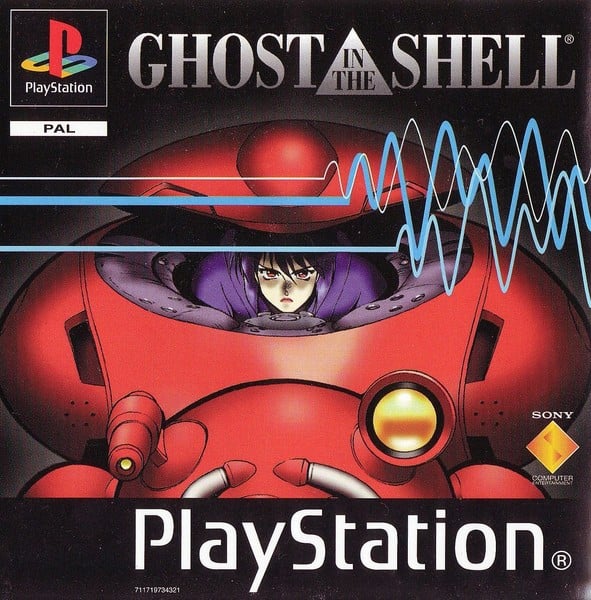
Ghost in the Shell (PlayStation Video Game)
What it is: A 1997 PlayStation 1 game from developer Exact that fuses concepts from the manga with the movie's cinematic sensibilities with art design that hews closer to the manga. No longer available to buy, it has never been re-released. Second-hand copies are expensive.
Worth playing?: Yes, if you can find it.
Why: If you ever wanted to control one of Section 9's cute, agile, and potentially incredibly destructive Fuchikoma “think tanks”, then here's your chance. Functioning as an “extra” story featuring Major Kusanagi and colleagues, this is a pretty fun action game. It retains some of the manga's humor, while also featuring (rather grainy, low-res) animated cutscenes from Production I.G—the same studio that made the film. It's not a very lengthy game and the low-res, pixelated, and dithered graphics look awful when blown up on a modern HD TV. I wish I'd never lost my copy when moving house years ago, as I can't justify the cost of re-buying it... If anyone wants to buy my empty original PAL game case with instructions (but sadly no disc), let me know…

Intron Depot 1
What it is: A dual-language (Japanese and English) Shirow-drawn artbook from 1991, focusing on his 1980s color art, from manga including Dominion, Black Magic, Orion, Appleseed, and Ghost in the Shell. It became available in the West even before Dark Horse published the GitS manga, offering fans a tantalizing peek at Shirow's next work. The English translations were by Toren Smith's Studio Proteus!
Worth reading?: Yes.
Why: Shirow's first art book was a preview of things to come from him. While he continued to sporadically produce manga volumes throughout the 1990s, eventually he gave up after MMI and focused instead on producing high-quality art books. Intron Depot 1, which is miraculously still in print, reasonably priced, and relatively easy to import, is worthwhile for any Shirow fan. While GitS material comprises only a small portion of the book, Shirow's little explanatory paragraphs are worth the price of admission alone—plus there are drafts and other unpublished artworks almost impossible to acquire anywhere else.
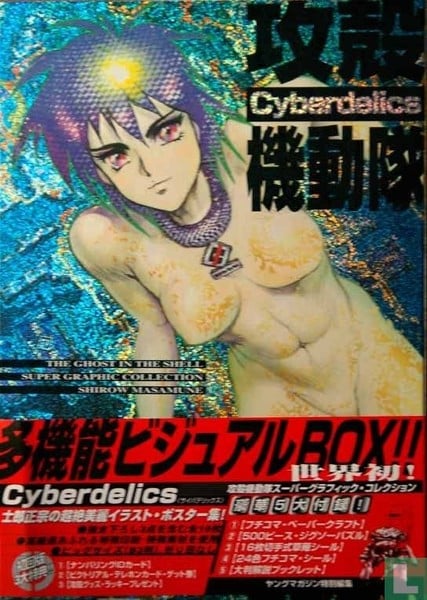
Ghost in the Shell Super Graphic Collection: Cyberdelics
What it is: A 1997 Japanese collection of ten large foil-embossed posters of Shirow's Ghost in the Shell color artwork.
Worth reading?: If you've money to burn, sure.
Why: These are among the most desirable items for serious fans of Shirow's artwork. Although copies of this poster collection do pop up online, they're hideously expensive. Due to the foil component, they don't reproduce with typical CMYK printing, so they've maintained their rare status. All is not lost, however…
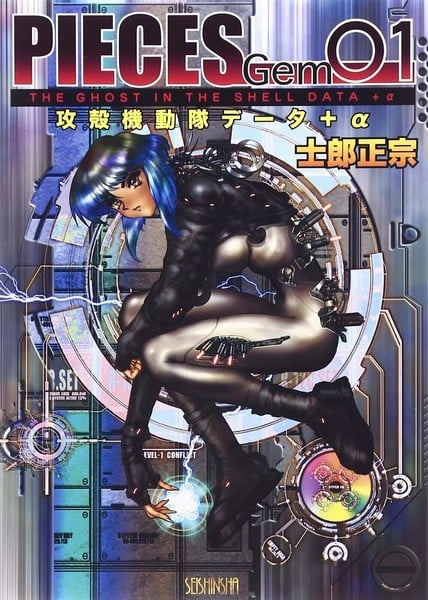
Pieces Gem 01 [Ghost in the Shell +Alpha]
What it is: A smaller, hardcover, more recent (2014) art book than Intron Depot 1, collecting a great number of rare GitS color images.
Worth reading?: Yes.
Why: For one, all of the Cyberdelics images are here, meaning this is a much cheaper way to acquire copies (though smaller, and sans foil highlights). Much of the volume is also given over to lengthy interviews with Shirow about his art and career in general. Some of his anecdotes are intensely personal and provide much insight into his mindset and work process. It's only in Japanese though…
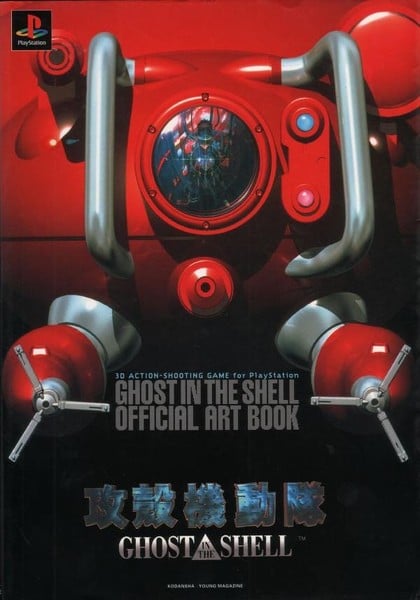
Ghost in the Shell Official Art Book
What it is: An 84-page (mostly) Japanese-language art book covering the production of the 1997 Ghost in the Shell PlayStation game.
Worth reading?: Yes, if you can find it.
Why: A relatively slim volume featuring multiple beautiful illustrations by the game's animation director/key animator Toshihiro Kawamoto (who would, in 1998, become co-founder of Studio Bones). The book features character and mecha designs, storyboards, screenshots, and many stills from the various Production I.G-produced in-game animation sequences which hew closer to the manga's aesthetic than the 1995 movie. Images representing Shirow's art are also found in his Cyberdelics collection, but this is the only volume I am aware of that features art directly associated with the game. There's a reasonable amount of Japanese text, though titles and headings are in English. It's an interesting curio if nothing else.
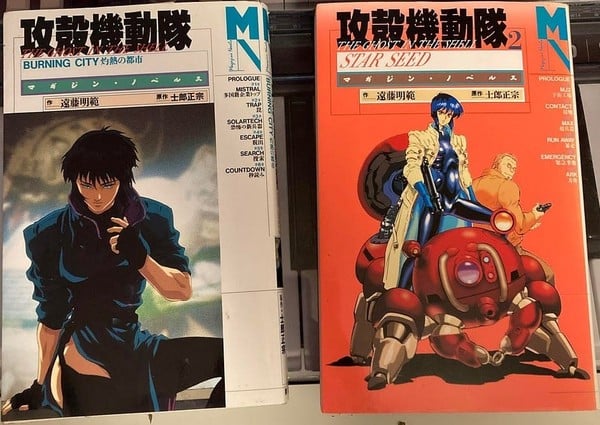
Ghost in the Shell: Burning City and Ghost in the Shell: Star Seed
What they are: Two tie-in novels by author Endo Akira, published in November 1995 and January 1998 respectively. They've never been translated into English, officially or otherwise, and information about their content is almost impossible to find on the English-language web.
Worth reading?: I've no idea.
Why: If you can find copies—and you can read Japanese… maybe these are worth your while. If you've read them, I'd love to hear what they're about…
The Main Movie Continuity
What it is: Famed director Mamoru Oshii (Urusei Yatsura, Angel's Egg, Patlabor) directed two theatrical movies based on the first volume of Shirow's manga.
What it's about: Sharing setting, characters, and plot with the original GitS manga, these are big-budget, landmark, influential films.
What should I watch first?: Ghost in the Shell, Oshii's 1995 movie.
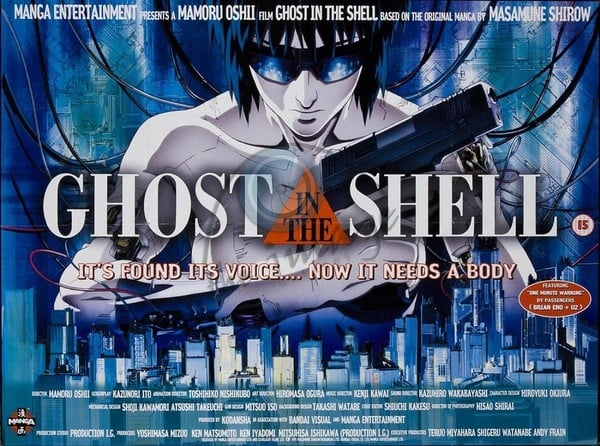
Ghost in the Shell
What it is: Oshii's first, 1995 GitS movie. Part-funded by the UK's Manga Video, it debuted on UK screens shortly after the Japanese premiere, before a U.S. release early the following year. Touted as the “next big thing” after Katsuhiro Otomo's Akira (1988), it became for many people a gateway drug into anime, and their first experience with Shirow's stories. It's impossible to overstate how influential Oshii's film was for Western popular culture. I mean, just take a look at the tone, appearance, and content of the Wachowski siblings' Matrix movies.
Worth watching?: Yes.
Why: Whether you vibe with Oshii's slow, contemplative, and clinical directorial style or not, it's hard to deny that his cinematic vision for Ghost in the Shell is anything short of remarkable. This is a gorgeous-looking movie with a distinctive, atmospheric (even slightly eerie) Kenji Kawai soundtrack. Taking a honed paring knife to Shirow's comparatively bloated and unfocused manga, Oshii hacks down to the core concepts and central conflict of the first volume — the relationship between an existentially troubled Motoko Kusanagi and the mysterious Puppeteer.
This version of Kusanagi lacks the humor and whimsy of Shirow's original—and Oshii's take on the material is serious, philosophical, and even slightly cold. It succeeds in streamlining and clarifying Shirow's central thesis, with Oshii adding his usual Biblical allusions. An incredibly concise movie, in only 82 minutes it achieves a miracle of complex narrative and existential contemplation—along with brief but spectacular action sequences. Personally, I miss Shirow's goofiness—and the absence of the Fuchikoma “think tanks” hurts—but it's an incredible film that deserves its place in the anime Hall of Fame.
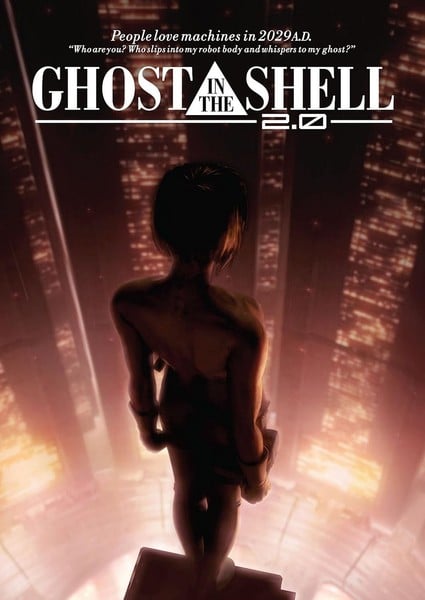
Ghost in the Shell 2.0
What it is: Mamoru Oshii's 2008 George Lucas-style “redo” of his 1995 Ghost in the Shell movie, with added CGI visuals and a new rust-colored filter.
Worth watching?: No. Watch the original instead.
Why not: Sometimes directors should be forbidden from revising their past masterpieces. Ridley Scott got away with it for Blade Runner, but this is not the case for this pointless exercise of splicing incongruously smooth and shiny CG with hand-drawn animation—and smearing everything in a horribly queasy orange filter. Supposedly this was done to match the aesthetics of the sequel movie Innocence but please just watch the original. The additions do nothing but detract from the purity of Oshii's original vision.
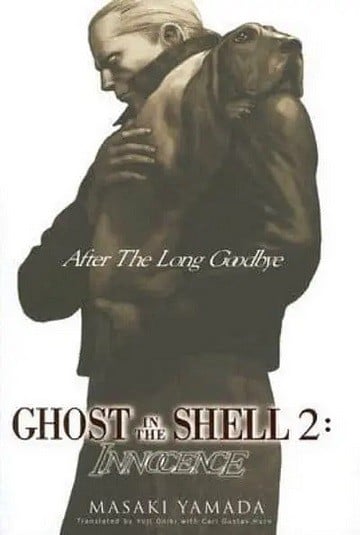
Ghost in the Shell 2: Innocence: After the Long Goodbye
What it is: A prequel novel to the second movie Innocence, following Batou as he copes with Major Kusanagi's disappearance. Written by Mamoru Oshii's SF author friend Masaki Yamada, it was released a few days before the theatrical premiere of Innocence in Japan. Good luck finding a copy though, the hardback English translation from Viz is long out of print, and there's no ebook version.
Worth reading?: Yes.
Why: A detailed, melancholic character study of a damaged man, After the Long Goodbye is an appropriate companion piece to its associated film. This version of Batou is a far cry from the grinning, wisecracking one-man-army of other franchise entries. However his introspection and unreliable narration explore some deep material about the concepts of love and loss. Its tone (and significantly different interpretation of cyberbrain technology) is unlike anything else in the franchise.

Ghost in the Shell 2: Innocence
What it is: Oshi's belated 2004 sequel to his 1995 film, loosely adapting two middle chapters from the manga's first volume. With Major Kusanagi having disappeared following the events of the first film, prosthetic-eyed Batou is the main character this time around. Together with ex-cop Togusa, the pair investigate a disturbing cybercrime.
Worth watching?: Yes. Maybe. It's complicated.
Why: Innocence is a film I want to love . The visuals are striking with (at-the-time) cutting-edge CG. Moreover, the underlying story concepts are fascinating but… Oshii drowns his film in ponderously long and circular philosophical mumbo-jumbo that strangles the already thin plot. Apart from a couple of truly excellent action sequences, Innocence is disappointingly lethargic.
Major Kusanagi has always been GitS' most interesting character, yet instead of making a film about what she did after her post-human apotheosis at the end of the preceding movie, Innocence mostly removes her from the narrative—barring a few scenes towards the conclusion. Poor, depressed Batou isn't quite so charismatic a lead. Perhaps Oshii can't be too criticized for this as Shirow's attempts to sequelize his own manga didn't go well either. Turns out that making movies about disembodied, decentralized, ascended, gestalt organisms is pretty damned difficult. Who'd have thought?
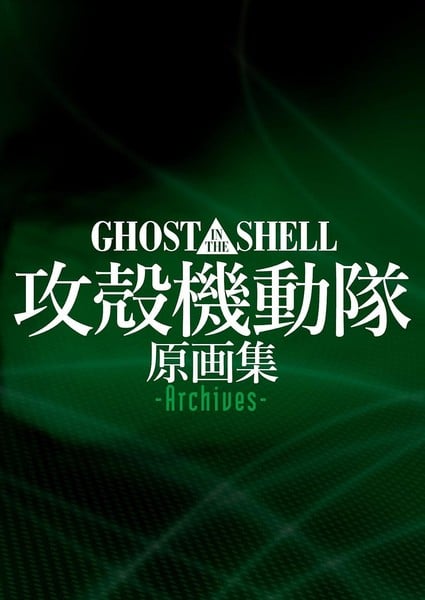
GHOST IN THE SHELL: Archives
What it is: A 288-page black-and-white oversized paperback art book featuring storyboards, key art, and production sketches from Oshii's 1995 movie. Published in 2014, the minimal text is in Japanese.
Worth reading?: Possibly.
Why: This is a relatively expensive Japanese import but it's full of high-quality production sketches you won't find anywhere else—some of which are really beautiful. There isn't that much text, so the language barrier isn't a huge issue here. Fans of Oshii's work who want more visual insight into the creation of his landmark movie would be well-served by this simply-presented, no-nonsense, yet exhaustive volume.

Ghost in the Shell 2: Innocence: The Ani-Manga
What it is: A four-volume set of attractive slip-covered paperback books, published in 2005 by Viz Media, utilizing over two thousand stills from the movie to construct a manga retelling. Comes in a nice box. Very out of print.
Worth Reading?: Yes, if you liked Innocence.
Why?: Innocence has gorgeous visuals. Each ani-manga volume is like a high-quality, pocket-sized art book packed with some of the best production design and cinematography ever put to animated film—plus it gives some extra insight into Kenji Kawai's song lyrics. If you care about the story, then you can relive it over the course of six hundred pages. Alternatively, you can just stare at the pretty pictures (two thousand stills!) to your heart's content.
The Ghost in the Shell: Stand Alone Complex Continuity
What it is: Stand Alone Complex is, in my opinion, the very best iteration of Ghost in the Shell. Comprising two 26-episode TV anime seasons, two compilation films, a sequel movie, and two belated CG-animated sequel seasons, it's also the most meaty. Chiefly written and directed by Production I.G.'s Kenji Kamiyama, it's also blessed with story input from both Shirow Masamune and Mamoru Oshii.
What it's about: Set in a future Japan between 2030 and 2045, Stand Alone Complex follows a version of Major Motoko Kusanagi who never met the Puppeteer, and never combined with them to become a new entity and leave Section 9. It's an alternate universe adaptation of the manga that tells its own story, yet integrates many aspects, characters, and concepts from both manga and movie. This is Ghost in the Shell as High Quality SF Police Procedural.
What should I watch first?: Stand Alone Complex
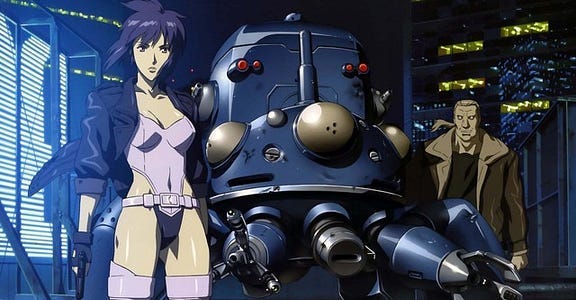
Ghost in the Shell: Stand Alone Complex
What it is: The 26-episode first season of Stand Alone Complex (SAC) first broadcast two episodes per month via Japanese pay-per-view Satellite TV from 2002 to 2003. Shown on Adult Swim in the U.S., it's still available to buy on DVD and Blu-ray.
Worth watching?: YES.
Why: Stand Alone Complex holds up as one of the best anime of all time. With fascinating characters closer to their manga counterparts than their movie iterations, we spend so much more time getting to know them. Major Kusanagi is a fantastic protagonist, despite her often… impractical… clothing style. She's at turns dryly humorous, coldly terrifying, mysterious, and enticing. It's little wonder that in every version of the story, Batou follows her around like a puppy. Theirs is a greatly understated not-quite-romance.
Alternating between mostly self-contained “Stand Alone” episodes and heavily serialized “Complex” episodes, SAC explores an incredibly well-realized future world that feels closer and closer with each passing minute. Although SAC's future won't arrive by 2030 in our world, surely we're only a couple of decades behind? While the central plot likely takes more than one viewing to fully absorb, I adore this show, and revisiting it recently only reinforced my appreciation for it. It's a TV anime masterpiece.
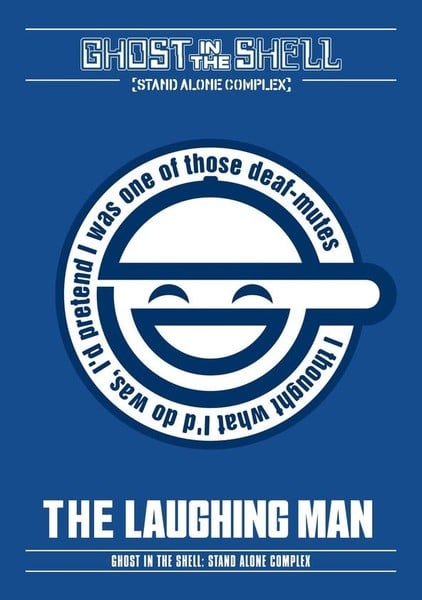
Ghost in the Shell: Stand Alone Complex: The Laughing Man
What it is: Director Kenji Kamiyama's 2.5-hour-long digest of the first-season-spanning “complex” Laughing Man arc plot. It's available on DVD and Blu-ray.
Worth watching?: No. Watch the first season instead.
Why: While it makes for a decent enough film in its own right, in heavily streamlining The Laughing Man arc, this movie removes so much of the essential connective tissue found in the “Stand Alone” episodes. You miss out on so much by only watching this version and it's completely extraneous to experienced SAC viewers.

Ghost in the Shell: Stand Alone Complex 2nd GIG
What it is: The 2032-set second season of Stand Alone Complex, with a new, even more complicated season-long arc. First broadcast over 2004–2005, it's still available on DVD and Blu-ray.
Worth watching?: YES.
Why: Rather than the more typical cyberpunk/hacker-focused first season, this is Ghost in the Shell gone full-blown military espionage war drama, and I love it. Its refugee-focused plot has become only more relevant with time, and the sneaky antagonist Goda is a great anime villain. Hideo Kuze, an important figure from Major Kusanagi's past makes his debut here. This time the even more heavily serialized episodes are split between “Individual”, “Dividual”, and “Dual” classifications—and the final eight episodes make for a relentlessly intense finale.
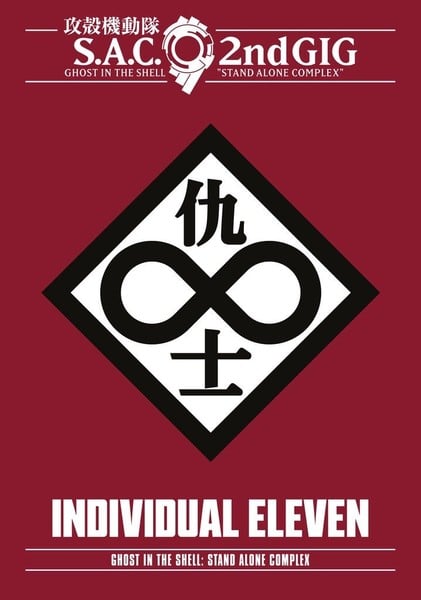
Ghost in the Shell: SAC 2nd GIG: Individual Eleven
What it is: Another 2.5-hour-long compilation movie from director Kenji Kamiyama—this time streamlining 2nd GIG's Individual Eleven arc. It's available on DVD and Blu-ray.
Worth watching?: No. Watch the second season instead.
Why: While Kamiyama does an excellent job of cutting down an otherwise unwieldy and complex plot into such a relatively tight runtime, so much narrative connective tissue is lost. Unless you're short on time, there are a few reasons to choose this version.
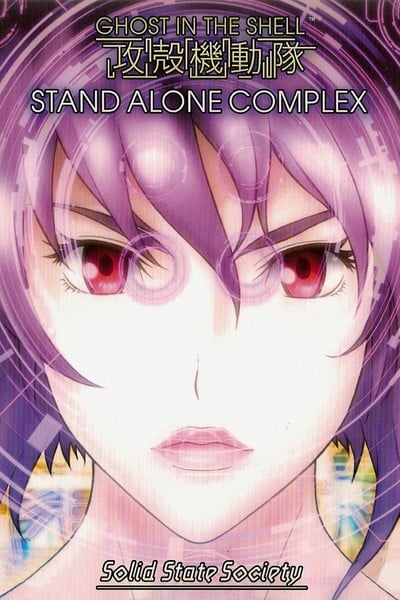
Ghost in the Shell: Stand Alone Complex: Solid State Society
What it is: The 2006 movie sequel to 2nd GIG, set two years later, in 2034. It's available on DVD and Blu-ray.
Worth watching?: Yes.
Why: While not as instantly classic as the two full preceding TV seasons, this follow-up crams almost a season's worth of plot into about four episodes' worth of runtime. Major Kusanagi is doing her own thing and Section 9 has moved on without her. I really like how the story integrates Roujin Z-esque social commentary on elderly care, while also featuring a truly disturbing child abduction sub-plot that hits close to home for doting father Togusa. There are plenty of nods to the first GitS movie as SAC gets its own “Puppeteer” equivalent. It's definitely worth watching as the “finale” to SAC in its original form.
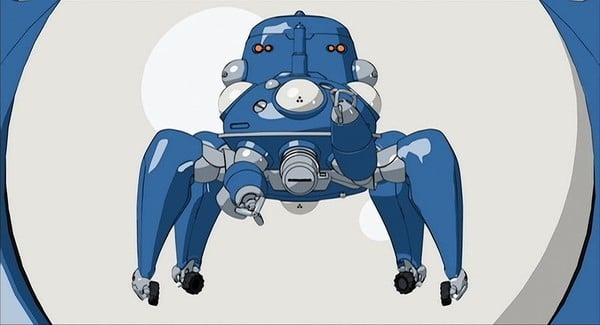
Tachikomatic Days
What it is: A 52-episode (plus three specials) series of one-minute comedy shorts starring everyone's favorite sentient blue weapons of mass destruction, Section 9's adorable Tachikoma mobile think tanks!
Worth watching?: Yes.
Why: Tacked onto the end of every SAC season one and 2nd GIG episode—with special episodes accompanying the DVD release of all three SAC films—each Tachikomatic Days installment is a concentrated dose of comic insanity. Untethered from the serious tone of their progenitor show, the child-voiced automatons cause chaos in their enthusiastic pursuit of new experiences, only sometimes referencing the preceding SAC episode.
Set in a strange blank white void, the CG Tachikomas cavort around comedically, musing on the meaning of life and existence, while playing pranks or blowing each other up. Although the humor may be a little hit-and-miss, these delightful shorts are worth watching, especially when they hit an unsuspecting viewer with surprising SAC plot-related pathos. Tachikomatic Days was never broadcast on U.S. TV but thankfully appeared on physical SAC releases and VOD services.
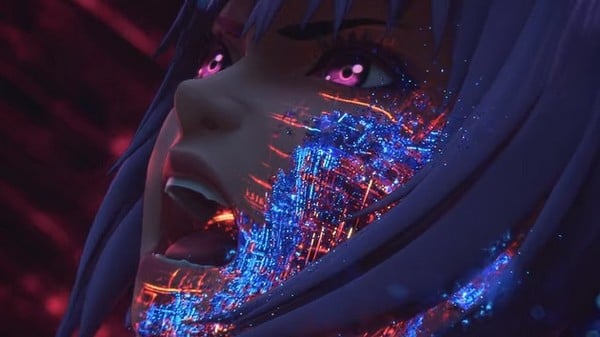
Ghost in the Shell: SAC_2045 Season 1
What it is: Fifteen years following the release of Solid State Society, writer/director Kenji Kamiyama belatedly followed up with a CG-animated sequel, set in 2045. The world has changed but Motoko Kusanagi has returned to lead her now-independent team. Now she's facing off against an enormous “sustainable war” conspiracy as well as the emergence of dangerous “post-humans”. This is the first batch of twelve episodes streaming on Netflix. A U.S. Blu-ray release (sub-only, Netflix is jealously guarding its English dub) was released on July 29th, 2024.
Worth watching?: Yes. Please stay with me here.
Why: The first thing everyone notices about SAC_2045 is the horrible plasticky CG animation that makes every character look like a soulless Barbie doll. Ilya Kuvshinov's gorgeous character designs can't make up for this unbelievably awful aesthetic misstep. Look, I can understand the folks who dropped this show but if you half-close your eyes and squint, it's the same old SAC as it ever was—with the same characters, the same damn writer and director, and the same confusing and complex plots. The new character, Purin Ezaki, is nails-down-a-chalkboard annoying, but… she'll get better. Honest. Visuals aside, SAC_2045 has a fascinating story and it's really good to have the old gang back in action. I may have an unpopular opinion on this but I mostly love SAC_2045—despite its flaws.

Ghost in the Shell: SAC_2045 Sustainable War
What it is: A 118-minute edit of the first twelve-episode season of SAC_2045.
Worth watching?: No.
Why: Unlike the two earlier Stand Alone Complex compilation movies, this does not hang together very well as a coherent film. If you really can't stand watching a full season of plasticky CG animation but still want the story basics, then it's passable. Otherwise, watch the full twelve episodes instead.

Ghost in the Shell: SAC_2045 Season 2
What it is: The second batch of twelve CG-animated episodes. Following directly on from the first season, this season is still written by Kenji Kamiyama, but this time, Shirow adaptation veteran Shinji Aramaki (various versions of Appleseed) takes over as director. It currently streams only on Netflix.
Worth watching?: Yes. Please believe me.
Why: Despite a real head-scratcher of an ending that made me both confused and unreasonably irritated, the concluding half of SAC_2045 is mostly a really good time. The new character Purin's arc is taken in a horrifying and tragic direction that raises all kinds of new existential questions—and the primary post-human threat is both compelling and weird. The animation has significantly improved, too (even if everyone still looks like cheap shiny figurines). It's not as essential as the original SAC, but I'm glad it exists—even if I wish they'd stuck with traditional 2D animation.
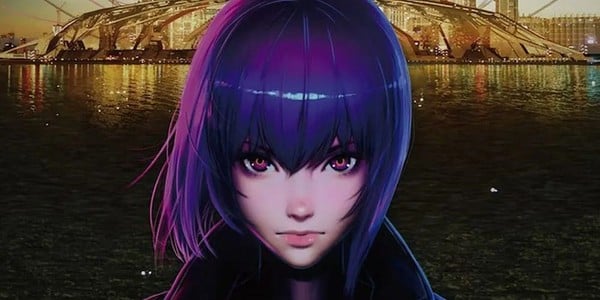
Ghost in the Shell: SAC_2045 The Last Human
What it is: A 126-minute edit of the second twelve-episode season of SAC_2045. Apparently, it has a different ending to the show.
Worth watching?: Unknown.
Why: Despite releasing theatrically in Japan in November 2023, Netflix has shown no indication of when it intends to stream this internationally. The Japanese Blu-ray was released on August 28, 2024, so perhaps we'll get it on streaming sometime soon?

Ghost in the Shell: Stand Alone Complex (Manga)
What it is: A five-volume manga written and drawn by Yu Kinutani from 2009–2012, adapting a single season one episode per volume. (Episodes adapted: 1: SECTION 9, 2: TESTATION, 7: IDOLATOR, 13: NOT EQUAL, and 14: ¥€$.) It's available in print from Kodansha USA and digitally on K Manga.
Worth reading?: No.
Why: These five volumes are a completely pointless exercise in stretching out single episodes' worth of content into over 250 pages each. They're like storyboards with the script added. They're far too slow-moving and they add very little extra insight. Why does this even exist? Just watch the anime instead and don't bother with this extraneous print version.

Ghost in the Shell: Stand Alone Complex: The Laughing Man (Manga)
What it is: Four volumes adapting season one's overarching Laughing Man arc, also written and drawn by Yu Kinutani from 2013–2016. Surprisingly, there's no English translation of this one.
Worth reading?: Probably not.
Why: It's only possible to read if you understand Japanese and are willing to import the print volumes. Given the preceding five volumes and their pointlessness, I don't imagine this is any better.
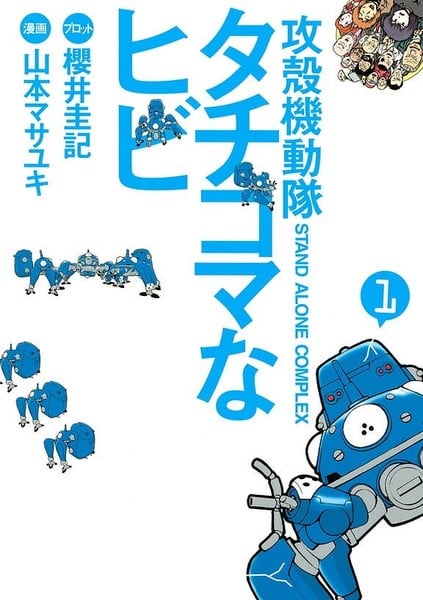
Ghost in the Shell: S.A.C. — Tachikoma na Hibi
What it is: An eight-volume comedy spinoff manga from Yoshiki Sakurai and Masayuki Yamamoto, featuring everyone's favorite little blue sentient Tachikoma tanks. Published by Kodansha between 2010–2015 in Monthly Young Magazine, there's no English translation available.
Worth reading?: Probably, if you can read Japanese!
Why: A few chapters were translated as bonuses for some of the Stand Alone Complex manga volumes and were pretty fun. It's a shame we got that manga instead of this one.

Ghost in the Shell: Stand Alone Complex novel 1: Lost Memory
What it is: The first novel written by SAC TV series veteran Junichi Fujisaku. It's set during season one and was published in English by Dark Horse in 2006. It's out of print but relatively easy to find second-hand.
Worth reading?: Yes
Why: Fujisaku's writing feels so “right” for SAC that this reads exactly like an unmade first-season episode. For fans keen for more of the same high-quality SF storytelling, this novel is an excellent choice.
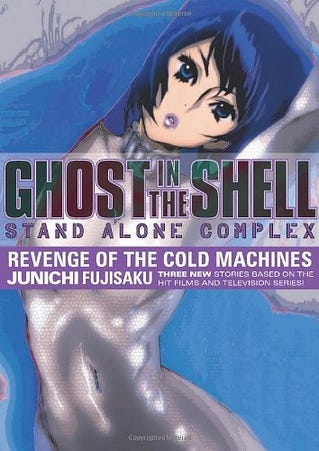
Ghost in the Shell: Stand Alone Complex Novel 2: Revenge of the Cold Machines
What it is: The second volume written by Fujisaku, this time featuring three linked novellas set during season one but integrating plot and theme elements from 2nd GIG. Published in English by Dark Horse in 2006, it's also out of print but relatively easy to find second-hand.
Worth reading?: Yes
Why: Fujisaku's writing quality remains excellent with spot-on characterization and these three shorter stories tie together at the end in a super-clever fashion.

Ghost in the Shell: Stand Alone Complex novel 3: White Maze
What it is: Fujisaku's third and final SAC volume, set during the first season's timeline but also featuring elements from both 2nd GIG and the previous novel. Published in English by Dark Horse in 2007, it's out of print like the other two books in the series but it's relatively easy to find second-hand.
Worth reading?: Yes
Why: A Kusanagi-centric volume, Fujisaku manages to maintain her mystique while giving us insights into her thought processes. Features a temporarily blinded Major remote-hijacking the visual inputs of the people around her so she can continue to fight. It's utterly badass.
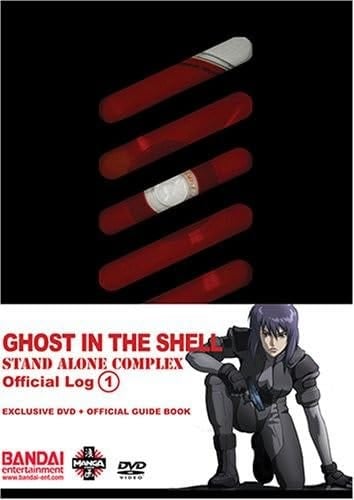
Ghost in the Shell Stand Alone Complex Official Log 1 DVD/Guide Book
What it is: A guidebook to the first nineteen SAC episodes, published by Bandai/Manga Entertainment in 2005. It's bundled with a 90-minute DVD filled with interviews and documentaries about the show. Out of print but available second-hand online for around its $50 recommended retail price. A second volume (Official Log 2) covering episodes 20–26 was initially scheduled for publication in English in 2006 but unfortunately never materialized. Official Log 2 remains available online in untranslated Japanese, along with two subsequent Japanese-only volumes: Ghost in the Shell: SAC - Ultimate Archive and Tachikoma's All Memory.
Worth reading/watching?: Yes!
Why: Oh my goodness, talk about information overload! This small-sized yet hefty volume is densely packed with background details about the production and story of Stand Alone Complex's first season. Maybe I'm getting old, but the teeny-tiny writing is very hard to read! Both the book and accompanying DVD are full of interviews and fascinating anecdotes—plus explanations for some of the more confusing aspects of the show. This is an invaluable resource for fans who want to dig deeper into the themes and world of SAC. My only complaint (other than now apparently needing reading glasses) is that the promised second volume never appeared in English. Shame on you, Bandai.
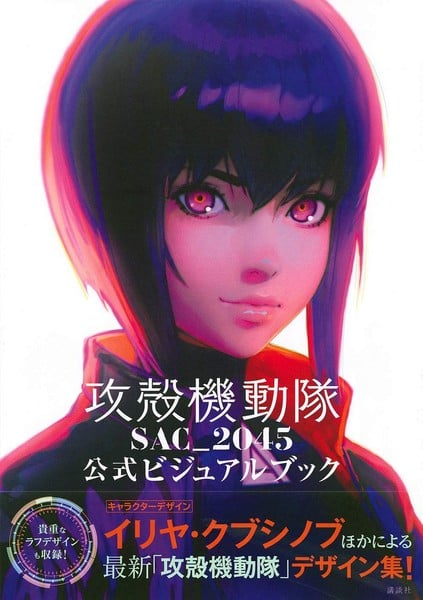
Ghost In The Shell SAC_2045 Official Visual Book
What it is: A 96-page oversized softback artbook from 2020 highlighting the SAC_2045 work of character designer and illustrator Ilya Kuvshinov.
Worth reading?: Yes
Why: Despite the plasticky appearance of the characters in the SAC_2045 anime, I adore Russian artist Ilya Kuvshinov's designs for them. His designs for director Keiichi Hara's Birthday Wonderland and Lonely Castle in the Mirror—plus the music video for Cyberpunk Edgerunner's ending song, Let You Down—are similarly wonderful. If you also appreciate Kuvshinov's unique and alluring visual style, this book—and its mix of gorgeous full-color illustrations and B&W drafts—is for you.
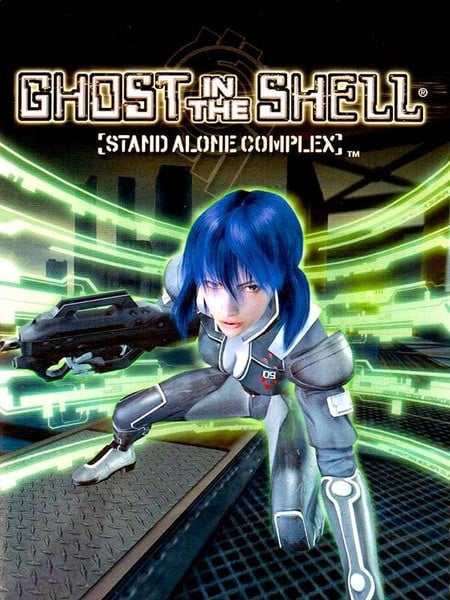
Ghost in the Shell: Stand Alone Complex (PlayStation 2 Video Game)
What it is: A 2004 PlayStation 2 third-person action game developed by Cavia (Drakengard, NieR Gestalt/Replicant) with a story set between the first season and 2nd GIG.
Worth playing?: Maybe.
Why: Releasing to mixed-to-middling reviews, this adaptation by now-defunct studio Cavia probably isn't a must-play for anyone but the most ardent completionist fans. Second-hand copies are climbing in price and it's never been re-released.
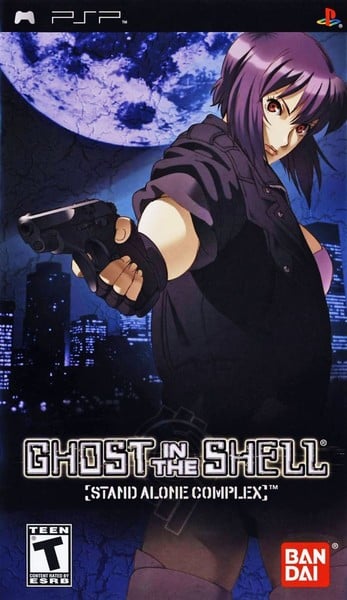
Ghost in the Shell: Stand Alone Complex (PSP Video Game)
What it is: A 2005 PlayStation Portable first-person shooter game developed by G-Artists. A sequel to the 2004 PS2 game, its story is also set between the first season and 2nd GIG.
Worth playing?: Probably not.
Why: Once again receiving middling reviews, this is another one for the completionists. The PSP's single analog stick really hampers the fiddly and over-complicated controls of this mediocre FPS-style game. I don't like this one at all.

Ghost in the Shell: First Assault — Stand Alone Complex Online
What it is: A 2016 free-to-play online PC first-person shooter from Korean developer NeoPle.
Worth playing?: Unfortunately, it's now impossible to play.
Why: Although this was a fun online shooter I briefly dabbled with, the worldwide version closed service in December of 2017.
The Ghost in the Shell: Arise Continuity
What it is: A series of OVAs from Production I.G. and chief writer Tow Ubukata released theatrically between 2013 and 2015, a 2015 TV show re-editing the OVAs, and a 2015 concluding movie.
What it's about: Pitched as a Ghost in the Shell prequel set in 2027, this iteration of the franchise stars a younger, less sure of herself Major Motoko Kusanagi as she gradually builds her team of specialists who will eventually become Public Security Section 9. Each story investigates cases related to the mysterious “Firestarter Virus”.
What should I watch first?: Ghost in the Shell Arise Border 1: Ghost Pain
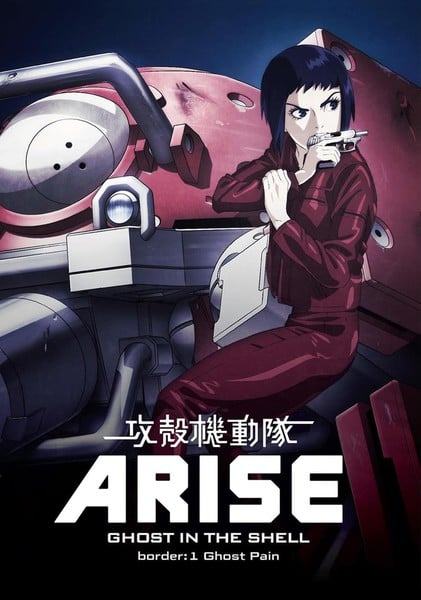
Ghost in the Shell: Arise
What it is: Initially released as a four-episode OVA series, with each episode named “Borders”, the first is Ghost Pain, second is Ghost Whispers, third is Ghost Tears, and fourth is Ghost Stands Alone. Later, a fifth OVA, Pyrophoric Cult, was released —but not in English. It streams on Crunchyroll.
Worth watching?: Maybe.
Why: Arise is a controversial constituent of the GitS franchise. Both Japanese and English versions use an entirely new voice cast, and the character designs are greatly altered. Tow Ubukata is a very different writer to SAC's Kenji Kamiyama and it seemed he was finding his feet here . Arise is much messier and less accomplished in terms of clarity of writing than his later Psycho-Pass 3 and its associated films. While Arise poses some fascinating questions and features truly intriguing concepts, none of these are given enough time or focus to be explored in depth.
By making her persistently more vulnerable, the Arise version of Major Kusanagi strays dangerously close to making her a damsel in distress. The new antagonists are unmemorable and the initial lack of connection between our beloved main characters means that all-important Section 9 camaraderie is sorely missed. Arise also needlessly breaks continuity with Stand Alone Complex, beginning yet another separate timeline with its irreconcilable changes to character histories. Also, composer Cornelius is a poor substitute for SAC's incomparable Yoko Kanno.
Arise looks fantastic, however, with some top-tier animation and design work. The prototype Logicoma think tanks are a lot of fun and Kusanagi gets to ride a slick red motorbike while wearing super-cool leathers to match.
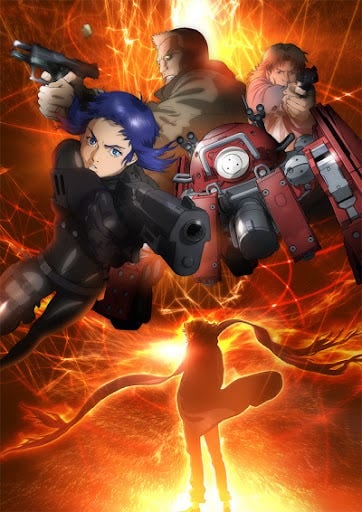
Ghost in the Shell: Arise: Alternative Architecture
What it is: A re-cut of Borders 1–4 into eight TV-length episodes that needlessly reorders them non-chronologically and adds two final episodes that comprise Border 5 — Pyrophoric Cult. It streams on Crunchyroll.
Worth watching?: No, except for episodes 9–10 (Pyrophoric Cult).
Why: Slicing up the OVAs into TV-length format while sacrificing footage was a baffling enough decision— but then re-ordering them so that Border 4 would be followed by Borders 1, 2, 3, and then 5 was incomprehensible. SAC writer Junichi Fujisaku's Border 5: Pyrophoric Cult isn't that important to the overall plot but it's a decent enough watch.
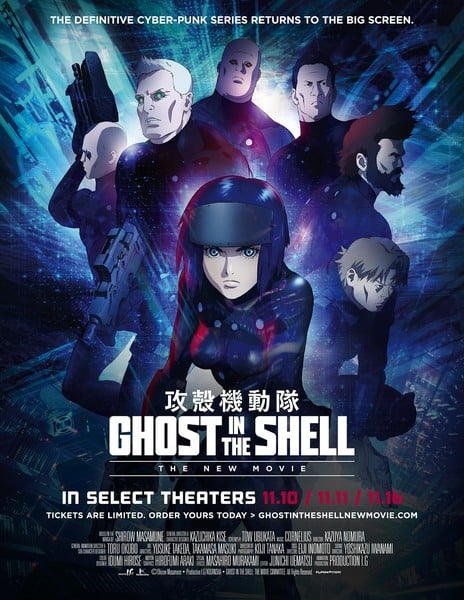
Ghost in the Shell: The New Movie
What it is: A movie directed by Kazuchika Kise and Kazuya Nomura, written by Tow Ubukata. It concludes the storyline begun in Arise: Borders 1–5.
Worth watching?: Yes (only if you've watched Arise, obviously).
Why: The New Movie is a surprisingly solid film in comparison to its predecessor OVAs. It doesn't do a great job of clarifying the overall murky meta-story but it remains compelling and covers some fascinating concepts. While not a huge step up visually from the already good-looking Arise OVAs, it still looks beautifully smooth and glossy—and has some fantastic action scenes. Most plot lines are tied off satisfactorily and it could almost be viewed as a direct prequel to Oshii's 1995 movie (which may have been intentional).
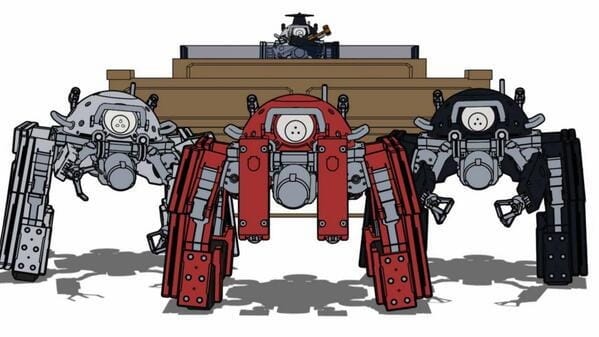
Ghost in the Shell Arise: Logicoma Specials
What it is: Four short three-minute specials accompanying each of GitS: Arise Borders 1–4, similar to SAC's Tachikoma Days, but this time featuring the less-advanced mobile think tanks, the bulky red Logicomas. These are available on the Arise DVDs and Blu-rays.
Worth watching?: Yes.
Why: These are funny little CG shorts where levity is the order of the day rather than serious SF drama. The episode titles are: Logicoma Beat, Logicoma Court, Logicoma Heart and Logicoma Root. There is another 3-minute short called Another Mission that acts as a prologue to Arise but it doesn't seem to have ever been released in English.

Kōkaku Kidōtai Nyumon Arise
What it is:A 2014 series of 26 4-minute promotional shorts broadcast on Japanese TV to advertise Ghost in the Shell: Arise. They were also bundled onto the Japanese Border 5: Pyrophoric Cult blu-ray. They have never been subtitled in English or made legally available outside of Japan.
Worth watching?: No.
Why: I learned of the existence of these shorts the day before this guide was due to be published, demonstrating the essentially bottomless rabbit hole GitS has become. A frenzied internet search upturned the first few unsubtitled episodes had been uploaded to YouTube. It appears to be a cheap, flash-animated series of advertising promos featuring anthropomorphic Logicoma girls Komako and Logiko (plus a grumpy, super-deformed version of Major Kusanagi) that features clips from various GitS shows and movies. Some episodes feature cameos from other GitS characters. Unfortunately, it's incomprehensible to non-Japanese speakers—though looks boring and pointless anyway.

Ghost in the Shell Arise: Sleepless Eye
What it is: Junichi Fujisaku and Takumi Oyama's 2013–2016 seven-volume manga retelling of GitS: Arise also includes all-new prologue and epilogue volumes.
Worth reading?: Yes!
Why: I told you we'd see Fujisaku's name pop up again. The veteran SAC writer lends his authorial pen to the Arise universe, starting with an excellent Asian War-set prologue arc relating the story of Major Kusanagi and Batou's first meeting. We then run through adaptations of Arise: Borders 1–4 but this time viewed through Batou's perspective, rather than the Major's. This offers excellent insight into some story aspects the anime left vague, clearing up a few plot holes very nicely. Oddly, Fujisaku doesn't adapt his own Border 5 for the manga, instead writing his very own, completely original epilogue. It's also excellent—and Takumi Oyama's art is super detailed and really beautiful.
I'd say that the Arise manga was essential reading to make the most of the anime-watching experience. It's a shame that English-language access is region-locked to US-only readers on the K Manga app. A VPN (for non-US readers) and a great deal of patience to deal with gated access to chapters via Premium Tickets and Points are required to read this manga in its entirety. Please publish this in print, Kodansha! Or at least issue a proper ebook version to save us from app-induced hell.

Ghost in the Shell Virtual Reality Diver (VR 360 Video)
What it is: A 15-minute VR experience from 2019, animated by Production I.G, directed by Hiroaki Higashi, and with a story by writer Junichi Fujisaku, set within the Arise continuity.
Worth watching?: Yes
Why: I had no idea this existed until recently. It's an incredibly slick and immersive VR video that's a bit like wandering through an extended high-quality videogame cutscene. There's an English dub that uses the Arise cast, and the story follows Major Kusanagi as she's woken up from a routine tune-up to combat a terrorist whose fake memories caused by the Firestarter virus are driving him to cause havoc. The short film includes an intense mech battle in “real” life, interspersed with flashy virtual world ghost-hacking. The viewer has full freedom to look in any direction at all times as the simple but effective story unfolds. I've never watched anything like this in my life. It's really, really cool, if a bit gimmicky!
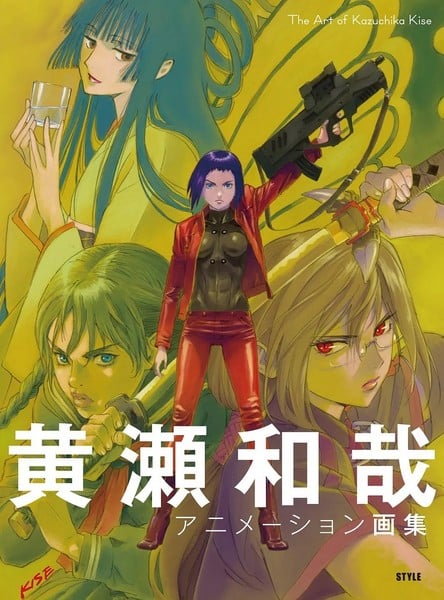
The Art Of Kazuchika Kise
What it is: A Japanese language oversized paperback art book with over 200 pages filled with color illustrations and keyframe drawings, covering multiple anime shows with input from animator/director Kazuchika Kise. In addition to Patlabor 2: The Movie, Blood The Last Vampire, and xxxHolic, a section of the book is dedicated to Ghost in the Shell: Arise.
Worth reading?: Probably not.
Why: For the asking price (somewhere between $80–100 on eBay), this may not be worth it for the relatively small section that covers Kise's Arise contributions. I'm not a huge fan of Arise's character designs, so it's not for me but fans of his other work might find it worthwhile. There isn't much text, so don't be put off by the fact that there's only a Japanese version.
The Ghost in the Shell Live-Action Movie and Miscellaneous Books
What it is: Hollywood's version of Ghost in the Shell and the flurry of tie-in book publishing it caused. None of these fit neatly into the other continuities, so I'll group them all here.
What it's about: Hollywood's ill-judged attempt to recapture fire in a bottle with a poorly-received live-action movie and its associated spinoffs.
What should I watch/read first?: Doesn't matter, none of these are directly linked with one another.

Ghost in the Shell
What it is: The Rupert Sanders-directed live-action Ghost in the Shell adaptation that takes its cues mainly from the 1995 Oshii movie, while also incorporating aspects from Innocence, Stand Alone Complex, and Arise. Released theatrically in March 2017, widely available on DVD and Blu-ray.
Worth watching?: No.
Why: Although WETA achieved undeniably spectacular visual results, with excellent practical effects mixed with hyper-detailed digital imagery, their contribution is about the only positive aspect of this entire endeavor. Ghost in the Shell (2017) visually references the franchise's breakout scenes constantly—re-enacting and re-interpreting such iconic aspects as the cyborg body production opening sequence, the Major's one-on-one battle with a spider tank, and her waterlogged thermoptocam-powered fight against a brainwashed cyber-hacker (among many other examples). Unfortunately, despite such obvious care and attention towards the superficial appearance and content of the story, Sanders and his committee of writers forgot to impart an ounce of intelligence, philosophical thought, or even soul to this disappointingly empty production.
Complex casting controversies aside, Scarlett Johansson at least looks the part of the Major, but her character is a poor shadow of the manga and anime original. This Major is a victimized, amnesiac waif with no identity of her own. There's no Puppeteer in this version, instead, there's a pathetically bastardized version of 2nd GIG's Hideo Kuze, who offers the Major a watered-down version of digital ascension, that she declines. In doing so, she invalidates the entire philosophical underpinning of the series—making this an infuriatingly pointless exercise in audience-patronizing, dumbed-down, generic sci-fi action movie guff. What a disappointment—and an absolutely unparalleled masterclass in Hollywood Spectacularly Missing The Point.
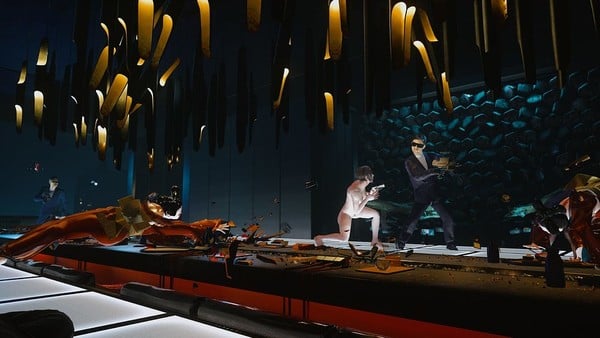
Ghost in the Shell: The VR Experience
What it is: A 4-minute long CG animation VR “experience” for Oculus Rift.
Worth reading?: No.
Why: Desperately inferior to Arise's superficially similar Ghost in the Shell Virtual Reality Diver (VR 360 Video), this "VR experience" is an ultra-janky, cheap CG monstrosity that looks laughably amateur. Don't bother with it.

The Art of Ghost in the Shell
What it is: A hefty, oversized movie tie-in hardcover art book, released in March 2017 that's now out-of-print and increasingly difficult to find at a decent price.
Worth reading?: Yes.
Why: While the movie as a whole may have been disappointing, for those who can appreciate the incredible production work that made the film at least look spectacular, this beautiful volume provides an invaluable focus on the behind-the-scenes artists and their creations. It's not their fault the script was awful. It's worth imagining what if these wonderful designs had been made in service of a better movie.
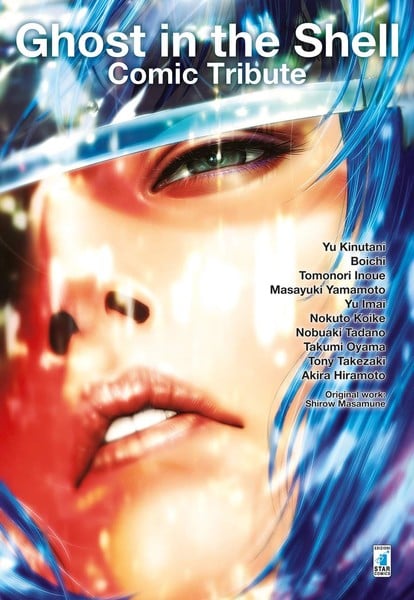
Ghost in the Shell: Comic Tribute
What it is: First published by Kodansha Japan in March 2017, this is a collection of GitS tribute manga from other Japanese manga creators. It's unpublished in English (why, Kodansha USA, why?) but available in French, Polish, or Italian.
Worth reading?: Yes, but it's difficult for English readers.
Why: If you're multilingual, or don't mind staring at pretty pictures while ignoring incomprehensible dialogue, this is a great volume, full of eclectic and fun manga stories from a wide selection of creators. Dr. Stone's Boichi provides some incredibly detailed almost-hentai art (maybe that's why there's no English release?) and the slightly unhinged Tony Takezaki channels the spirit of early 1990s Masamune Shirow to an almost upsettingly accurate degree. I love this anthology and wish it was more easily available.

Ghost in the Shell: Five New Short Stories
What it is: Published in English by Vertical in April 2017. These five short stories don't appear to be set in the movie universe.
Worth reading?: Yes, mostly.
Why: This is a fairly slim volume with stories of variable quality—not all of which directly feature the core Section 9 cast. By far the best is Heterochromia by Gakuto Mikumo which appears to be set in the future of either the original manga or 1995 movie universe. Soft and White by Kafka Asagiri is the longest entry and is also a good read. It ties very cleverly into the Stand Alone Complex universe.
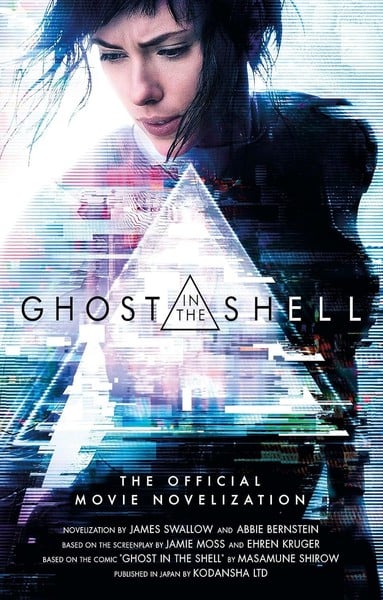
Ghost in the Shell: The Official Movie Novelization
What it is: A novel written by James Swallow and Abbie Bernstein, based on the screenplay by Jamie Moss and Ehren Kruger. It was released in September 2017.
Worth reading?: No.
Why: While Swallow and Bernstein's prose is completely adequate for the task, there's little else of value here. Strip away the movie's incredible visuals and all that's left is a thin, empty, philosophically desolate story with nothing to say. There's little extra character insight, no extra scenes, and the dialogue comes ripped straight from the script with little embellishment. The descriptive text is like having someone constantly narrate the film to you as you watch! You might as well watch the movie, or better yet, read or watch anything else in this guide.

Ghost in the Shell README: 1995–2017
What it is: An English-language hardcover coffee table book from Kodansha USA, basically a translated version of the equivalent Japanese Perfect Book 1995–2017. Published in November 2017 and now out of print, it goes for hilariously inappropriate prices online. Covers the entirety of the TV and movie franchise, from Oshii's 1995 film up to the 2017 live-action version.
Worth reading?: I'm not sure. Probably.
Why: This is the only English-language book I've been unable to source for this overview because of the unreasonably expensive online reseller asking prices. From YouTube videos and screencaps I've seen, it appears to be a handsome volume full of fascinating insight. I want it, but I'm not spending a hundred pounds (or more!) for the pleasure.
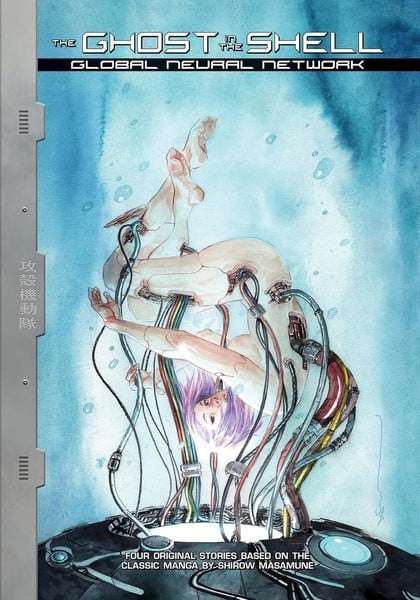
The Ghost in the Shell: Global Neural Network
What it is: Published in hardback by Kodansha USA in July 2019, this is a second compilation of GitS tribute comics, this time from non-Japanese comic creators.
Worth reading?: Yes
Why: Although it's a shame Kodansha USA chose to publish this volume rather than the superior Comic Tribute, this is still an interesting collection. Although the artists are multicultural — one is American, one Greek, one Spanish, and one Italian, every writer is an American. The stories are mostly US-centric too, which I suppose offers a different viewpoint on the GitS universe. The best story, with gorgeous art, is undoubtedly Star Gardens by Brenden Fletcher and LRNZ—though I also like Redbloods by Alex de Campi and Giannis Milonogiannis for its almost manga-esque art.
That's finally the end! This has been an incredible detective journey to find absolutely everything relevant to the discerning Ghost in the Shell fan that's ever been available in English, or is at least worthwhile to look at in Japanese. Every time I thought I was done, more things appeared! I'm sure there are other Japanese-only items I've missed out, but I think this list has been definitive enough, yes?
Almost every single one of the above items has been intensely examined, in detail, by me, on my own blog. If you're so inclined, you'd be so welcome to come on over and peruse my enormous list of Ghost in the Shell (and other) reviews. Thanks for reading! I think I'm all cyber-brained out for now…
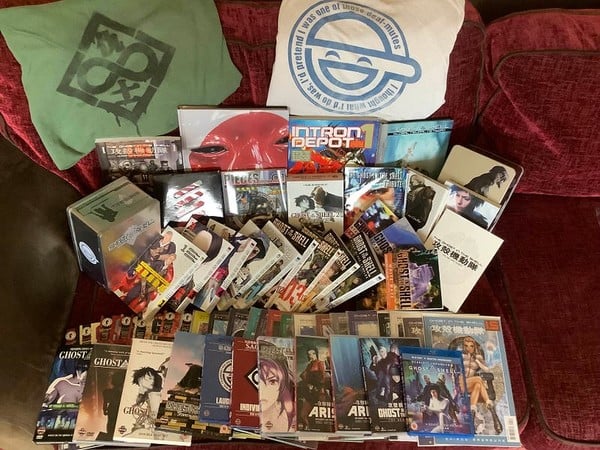
Here's a picture of my absurd collection accrued during the writing of this article, sans a couple of artbooks and video games…
Kevin Cormack is a Scottish medical doctor, husband, father, and lifelong anime obsessive. He writes as Doctorkev at https://medium.com/anitay-official and appears regularly on The Official AniTAY podcast. You can also find him on Twitter @Herrdoktorkev. His accent is real.
discuss this in the forum (19 posts) |